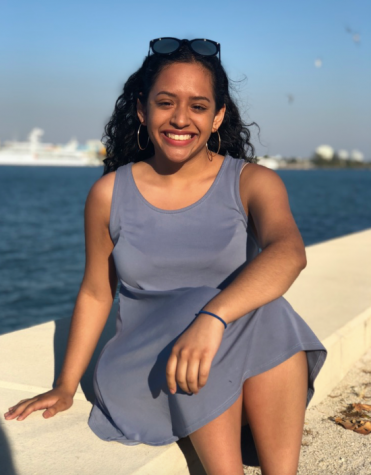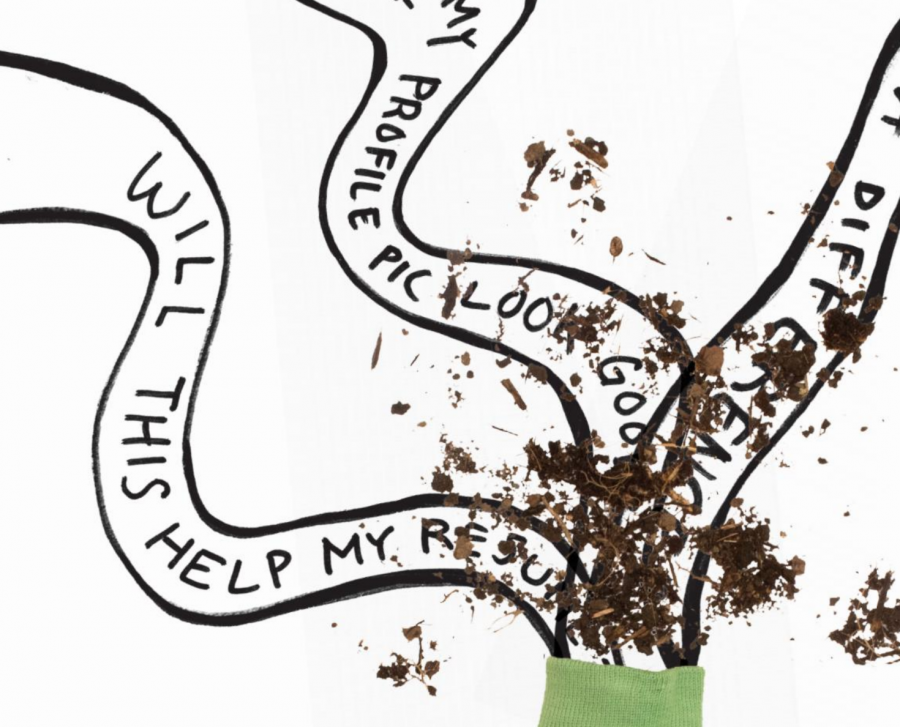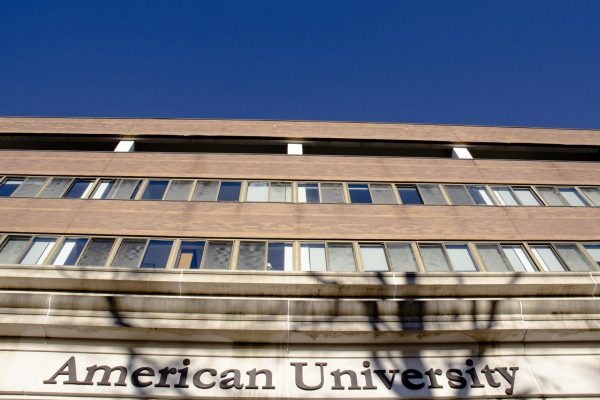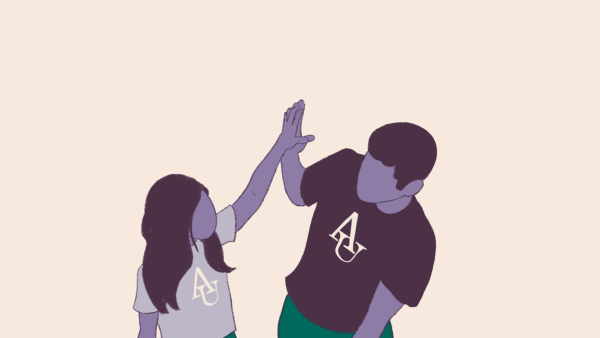Community Dwellers
Service-learning at AU
Art by Andrea Lin
Emma Dion, a sophomore at American University, had to accept that her first days of volunteering at Thrive DC, a local nonprofit working to end homelessness, would be just as awkward and nerve wrecking as she was expecting. At the time, Dion was participating in one of AU’s service-learning programs and had high hopes of making a mark in The District. However, she also knew that she, a white college student, would not fit in with the primarily Black and Latinx population she was serving. Dion was an outsider amongst the crowd and had a hard time adjusting to the realities of service in a diverse community.
Dion’s experience is not an isolated one. Many college students are signing up for service opportunities and classes, ignoring or disregarding the deeper questions and understandings needed to do service.
“I think most students sign up for ‘to change the world’ and literally in the first weeks of the course you learn that just wanting to change the world is not enough,” said Amanda Choutka, a service-learning professor at AU.
This reality can sometimes dissuade students from participating. However, universities still believe that students can learn and have an enjoyable service experience.
AU has developed multiple programs to engage students in meaningful service. One popular route AU students take is service learning courses.
Service-learning engages students in community service activities with intentional academic and learning goals and opportunities for reflection that connects to their academic disciplines.
Professors tend to support service-learning more than regular volunteering.
“Volunteering isn’t bad and it can be helpful and necessary, but it tends to more about the person volunteering and not the [service] outcome,” said Paul Albergo, a Professor for the School of Communication and service fraternity Alpha Phi Omega, faculty advisor.
“Service-learning is about addressing the outcome and alleviating the suffering [of others] and fulfilling a need,” Albergo said. “Service-learning should be part of the education model.”
Universities participate in these service-learning based courses and activities because it gives their students more of a hands-on experience with what they are learning in class. Students can develop critical thinking skills and focus on issues they are learning about in the classroom.
“Service-learning is important and if done well [students] can get away from the hero complex,” Albergo said. “[Students] learn the systemic roots, causes and find out successful and unsuccessful solutions. [Students] gain small pieces of knowledge and problem solving.”
As such, the AU’s Center for Community Engagement and Service (CCES) focuses on issues directly tied to the D.C. community and what students are learning in the classroom. Community service coordinator Harry Gillard argues that critical service learning helps students understand the multi-fold meaning behind issues in communities and educates and impacts students more.
“CCES want our students to have a critical service learning approach because the work we do is justice based and focused on issues in D.C.,” Gillard said. “It helps begin a dialogue with students and tie it to academics.”
AU has made multiple efforts to create a pool of long term volunteers. The School of International Service has developed a partnership with Peace Corps to train and engage students for future service projects. The Peace Corps Prep program has ranked No. 1 among medium size schools for Peace 2017 Top Volunteer-Producing Colleges and Universities list. Fifty-four alumni are currently volunteering worldwide.
Although AU benefits from the good press and its community-oriented students, it is also vital to ask students why they are participating in service. Knowing why students are participating can help professors and community partners advertise and plan according to students needs.
Furthermore, it is important to know students’ expectations because many start with unrealistic expectations about their power and ability to change and fix community problem. These ideas can cause more damage than good, as Professor Choutka states. These are further explored in trainings.
Another reason students may participate in service is for self serving motives. Some are innocent like wanting to learn more about the D.C. community, while others may want service experience for their resumes.
Dion argues that self-interested motives do not help create meaningful service.
“First and foremost, if you are not interested in doing service you should not be in a service-learning class,” Dion said. “You are just being a nuisance to the service location because you are not actually dedicated and there is not goal for you.”
However, some service-learning facilitators state that it does not matter the reason why you serve because no volunteer has 100 percent selfless intentions.
“You do not have to be selfless, but your intentions are important in how you interact with the community — be empathetic and have compassion,” Gillard said. “Have those qualities so you can work with vulnerable communities.”
Whatever the motives are for students in service, one thing is clear: they need to be trained.
“Sometimes good intentions are not all good that is why we have to training,” Gillard said.
Training then becomes an essential part part of service-learning.
“Most students have to learn to listen. And learn how to do what they are told,” Choutka said. “In the beginning, everyone has to soak in the information.”
The CCES oversees trainings for both professors and students. Gillard explains that the office’s role is to help teach the service-learning pedagogy and prepare students for service scenarios.
For the Community Service-Learning Program (CSLP), a one credit add-on course for service, students must attend a two hours training session. Students go over different scenarios of what can happen during service, learn about resources the school provides, and discuss the systemic causes behind the social issue they will be focusing on.
Training can change depending on the service project. However, each CCES training session revolves around the service-learning pedagogy.
The service learning pedagogy uses the concepts of critical reflection, reciprocity, and developing authentic relationships with communities. As the director for CSLP Gillard has worked with countless students as they begin their service projects.
“The importance for training, for me, is preparing students to go into the community, but also understand that they should be reflecting the entire process,” Gillard said. “Reflection connects what you are learning to academics — it connects service and learning together.”
Additionally, he says that the CCES focuses on providing a support system to students who may face challenges and questions when entering vulnerable communities.
Choutka believes the CCES office holds professors’ accountable and up to date on issues related to service learning and social justice.
“Service-learning at AU has to be approved by CCES office,” Choutka said. “When I make a significant change to the syllabus, it has to be approved again.”
Additionally, Choutka invites the office to speak to her students to prepare them for situations that may arise during service. She has also invited community partners like Thrive DC and Horton’s Kids, a nonprofit that services kids in Wellington Park, to speak to her class and give students an idea of what the service would be like.
Both the CCES office and Choutka believe students are going out well prepared for service and learning experiences. However, students have a different perception of how they are being trained.
“A lot of the class wasn’t really preparing us for the community,” Dion said. “Through the class I did not have a lot of preparation. I wish I had more structured help in the classroom. I wish Professor Choutka had given us more readings [on service and preparation]. If we had two weeks of preparation it would have been better.”
Dion states it was only when she was on her way to Thrive DC that she prepared herself for service. She remembers thinking, “I am about go volunteer and this time is valuable for me and the people I am working for.”
While Dion’s experience turned out okay, other students may not be as lucky — especially when students do not match the demographic that they will be serving.
“The type of student that usually participates in service-learning is usually a white female,” Gillard said. “The student is ambitious, who probably has service experience in the past, or an experience that triggered them to give back.”
According to the Community-Service Learning Program 2016-2017 student data, the majority of students were females, making up 83 percent of the 60 participants. Additionally, the majority of students were in the College of Arts and Science with 45 percent making up the participants.
The white, female volunteer is not just the norm at AU but also in the United States at large. According to a 2015 volunteering report from the Bureau of Labor Statistics, 26.4 percent of volunteers are white and 27.8 percent are females.
The demographic of AU volunteers is a representation of the people who volunteer in the U.S. However, it that does not mean the service will be problematic or unsuccessful.
Gillard, however, still wishes more black males at AU participated in service. He argues that their service could have more impact because “we [CCES] go into under resourced community especially youth, and there is a need for good role models.”
“I will say it, the reach can’t go as far,” Gillard states. “Because students, specifically under-resourced students, need somebody who looks like them so they can see that if that person succeeds [then] I can as well.”
While a more diverse pool of volunteers would be ideal, the CCES believes it has good volunteers.
“It is more important to be understanding,” Choutka said. “Everyone has privilege and it okay to recognize your privilege and then move because then it is time to act.”
AU students are active in issues that are important to them. Even though some students may be entering diverse communities for the first time, as long as they want to serve, it can be a good experience.
“These are the people [white female volunteers] who want to serve and though it not be ideal for a particular group [community partners] at the end of day there is willingness, knowledge, and compassion empathy to serve,” Gillard said.
Service-learning is a unique experience. No one can have the same service experience because they all come from different backgrounds and knowledge. Regardless, every student can learn and grow through service because it challenges their thinking and actions.
“Be open minded and take in everything,” Gillard said. “[Students] may be uncomfortable but that is alright, just be open minded and really invested in the experience because you will grow from it, especially if done right.”
Stephanie Lopez is a sophomore studying public relations and minoring in Spanish.

I'm a junior studying Public Relations and Spanish. My areas of interest are too many things to write down but I love food, reading sci-fi books, and...







